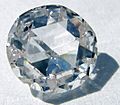Chemical vapor deposition facts for kids
Chemical vapor deposition (often called CVD) is a clever way to put a very thin layer of one material onto another surface. Imagine painting something so thinly that you can still see through it! This process uses very low heat, which is great for delicate materials like glass. It lets you add a metal coating to glass without melting or damaging it.
This cool technology was invented by Professor Roy Gordon at Harvard University in the 1970s. His team then made it even better in the 1980s. Today, CVD is used in many different ways.
For example, CVD helps make hip replacement joints lighter, stronger, and last longer. It's also used to create the screens for your flat-screen televisions and computer monitors (called TFT displays). You might also find CVD at work in your home, preventing double-pane windows and supermarket freezer doors from fogging up. And believe it or not, CVD can even be used to grow amazing synthetic diamonds!
Contents
How CVD Works
Chemical vapor deposition uses special gases to create thin layers. These gases contain the atoms needed for the new coating. When the gases touch a hot surface, they react. This reaction leaves behind a solid, thin film on the surface.
The Process Steps
The CVD process usually involves a few key steps:
- Gas Delivery: First, the right gases are carefully mixed and sent into a special chamber.
- Reaction Chamber: Inside the chamber, the gases flow over the material that needs coating. This material is called the "substrate."
- Heating: The substrate is heated to a specific temperature. This heat helps the gases react and form the solid layer.
- Deposition: As the gases react, atoms from the gases stick to the hot surface, forming a thin, solid film.
- By-product Removal: Any leftover gases or by-products are safely removed from the chamber.
Why CVD is Important
CVD is very useful because it can create coatings that are:
- Very thin: Layers can be just a few atoms thick.
- Strong and durable: These coatings can make materials much tougher.
- Pure: The layers are often very clean and free from unwanted materials.
- Even: The coating spreads out smoothly and evenly over the surface.
Uses in Everyday Life
CVD technology is all around us, even if we don't always see it.
- Electronics: It's key for making tiny parts in computers and smartphones.
- Medical Devices: Coatings on medical tools and implants make them safer and last longer.
- Energy: It helps create better solar panels and fuel cells.
- Tools: Cutting tools can be coated with super-hard materials using CVD, making them last longer.
Synthetic Diamonds from CVD
One of the most exciting uses of CVD is making synthetic diamonds. These are real diamonds, but they are grown in a lab instead of deep in the Earth.
- How it works: Scientists use a small diamond "seed" and place it in a CVD chamber. Carbon-rich gases are introduced and heated. The carbon atoms from the gas slowly attach to the seed, growing a new diamond layer by layer.
- Why it's cool: These lab-grown diamonds can be used for jewelry, but they are also very important in science and industry. They are used in cutting tools, electronics, and even for scientific research because they are incredibly hard and can handle extreme conditions.
Images for kids
-
A violet plasma helps grow carbon nanotubes in a lab machine called PECVD.
See also
 In Spanish: Deposición química de vapor para niños
In Spanish: Deposición química de vapor para niños




